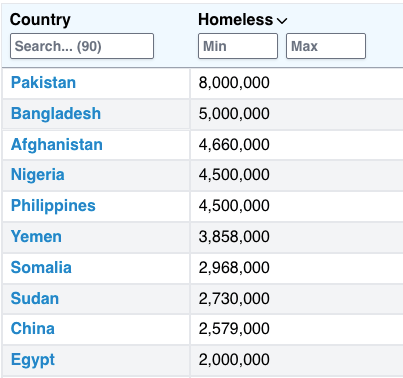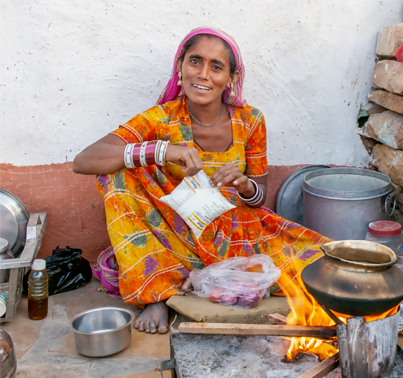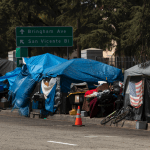In the vast expanse of our world, amidst the marvels of technology and the abundance of resources, lies a stark and grim reality that pervades every nation, every city, and every community: homelessness. This global phenomenon, often tucked away in the shadowed corners of society, presents a multifaceted challenge that transcends geographical boundaries and economic statuses. “Homeless People of the World” serves not just as a statistical representation but as a sobering reminder of the magnitude of individuals without a place to call home, striving for dignity in the face of adversity.
Introduction
As we delve into the heart of this issue, it becomes evident that homelessness is not merely a matter of lacking physical shelter; it’s a complex interplay of root causes (like drugs, alcohol, mental illness, broken relationships, and poverty), social, economic, and systemic factors that leave millions vulnerable. From the bustling streets of major metropolitan areas to the quiet byways of small towns, the specter of homelessness looms large, affecting individuals and families across the spectrum of age, race, culture and nationality.
The concept of “Homeless People of the World” population might seem an abstract notion, yet it represents a tangible reality for approximately 150 million individuals globally, as reported in recent years. 1 This staggering number underscores the scale of homelessness, a crisis that requires immediate and sustained intervention.
Brief Overview of Homelessness as a Global Issue
Globally, homelessness manifests in various forms, influenced by an array of contributing factors. In countries like India and Nigeria, rapid urbanization, poverty, and lack of affordable housing have propelled the crisis to the forefront. Meanwhile, in developed nations such as the United States, systemic issues like income inequality, mental health struggles, and the scarcity of social safety nets exacerbate the plight of those without homes.
Despite the diversity and interweaving of its causes across the globe, the experience of homelessness universally entails not just the absence of a physical dwelling but also the deprivation of security, privacy, and the foundation for personal and social development. It’s a condition that significantly hampers one’s ability to participate fully in society, access employment opportunities, maintain health and well-being, and nurture relationships. Sadly, the relationship issues, mental health and substance abuse issues impact the homeless’ ability to interact with society, gain employment, maintain health and engage in relationships. It really is a horrible cycle that is inescapable without a program that provides answers and solutions to all of those issues, like Homeless No More.
The “Homeless People of the world” concept invites us to explore the scale of this issue, shedding light on the pressing need for comprehensive strategies that address not only the symptoms but the root causes of homelessness. It challenges us to reconceptualize our approach to housing as a fundamental human right, deserving of concerted effort and innovative solutions.
In our quest to understand and ultimately resolve the crisis of homelessness, it is crucial to recognize the individual stories behind the numbers. Each statistic reflects a life marked by struggles but also resilience in the face of daunting odds. By bringing these stories to the forefront, we can foster a deeper understanding of homelessness and galvanize action towards creating a world where everyone has a place to call home.
In this conversation on global homelessness, we embark on a journey of awareness and empathy, confronting the stark realities while also uncovering the potential for transformative change. The path forward requires unity, compassion, and unwavering commitment to the dignity of all individuals. Together, we can chart a course towards a future where homelessness is no longer a global lament but a challenge to overcome.
Highest Homeless Population in the World
In the intricate mosaic of global homelessness, certain nations emerge with particularly high numbers of individuals living without homes. This distinction is not one of honor, but rather a clarion call for urgent action and compassion.
Countries like India and Nigeria find themselves grappling with the stark reality of homelessness on an immense scale. In India, the challenge is exacerbated by rapid urbanization and poverty, while in Nigeria, despite its abundant resources, access to wealth remains a pivotal issue.
The factors contributing to these alarming figures are as complex as they are varied. Unaddressed root issues, economic instability, lack of affordable housing, social inequalities, and, in some cases, natural disasters and conflicts, play significant roles. These issues underline the imperative need for systemic solutions that address the root causes of homelessness, transcending mere temporary fixes.
Get Homeless No More for Your Shelter, Non-Profit or Business.
Help Put Someone On The Road To A Better Life
As we confront the reality of homelessness, it’s crucial to remember that change is within our grasp. Homeless No More has demonstrated remarkable success in making a tangible difference in the lives of those affected. With a success rate of 90% in transitioning individuals off the streets, our program stands as a testament to what can be achieved with dedication and support.
You can play a pivotal role in this journey. Your contributions, whether financial, voluntary, or even through spreading awareness, can help extend the reach of our program, ensuring that more individuals have the opportunity to live meaningful, stable lives. See how you can help in our mission to reduce homelessness and transform lives across the US and, hopefully, the world. Together, we can make a difference, one life at a time.
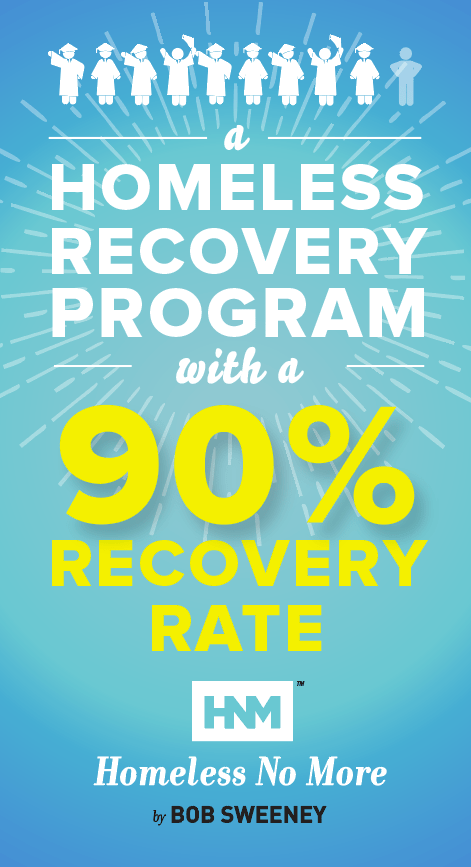
Top 10 Homeless Countries
In an unsettling reflection of global disparities, certain countries bear the brunt of homelessness more severely than others. Here, we explore the top 10 countries grappling with the largest homeless populations, shedding light on the complex tapestry of challenges they face. 2
- Pakistan, Bangladesh, and Afghanistan with its vast population, sees a significant number of homeless individuals, particularly among migrant workers and those affected by natural disasters. Millions of people are displaced due to economic struggles, conflicts, and lack of housing.
- China, similarly, China sees a significant number of homeless individuals, particularly among migrant workers and those affected by natural disasters. 3
- India and Nigeria stand out with staggering numbers, attributed to a blend of economic hardship, rapid urbanization, and inadequate access to resources.
- The United States, despite its wealth, contends with over half a million individuals without homes on any given night, revealing deep-seated issues of inequality and insufficient social safety nets as well as failure to address the root causes of homelessness.
- The Philippines and Yemen also feature prominently, with homelessness exacerbated by natural calamities, poverty, and political instability.
- Brazil, despite its economic growth, struggles with homelessness, influenced by urban poverty and housing shortages.
The roots of homelessness in these countries are deeply intertwined with social, economic, and political factors. Economic instability, insufficient affordable housing, social inequalities, and in some cases, the aftermath of natural disasters and conflicts, play significant roles in propelling the homelessness crisis.
U.S.A: Homelessness by State Per Capita: A Comparative Analysis
When we shift our focus to homelessness on a per capita basis, it presents a nuanced understanding of how deeply this issue is ingrained across different societies. Analyzing homelessness per capita allows us to examine the intensity of the problem relative to the size of a country’s population, offering insights into the effectiveness of national policies and social support systems in addressing this crisis.
The Contrast of High and Low Rates
In the U.S., states like California, Vermont, and Oregon are highlighted for having the highest rates of homelessness in the United States, with Washington, DC, showcasing the highest rate overall. On the other end of the spectrum, states like Mississippi report the lowest rates of homelessness. 4 This disparity underlines the impact of various factors, including housing costs, availability of social services, and the challenges in counting the homeless population accurately.
Socioeconomic and Political Influences
The reasons behind high homelessness rates per capita in certain areas are multifaceted. Underlying root causes or triggers, high housing costs, economic instability, and insufficient social safety nets are common contributors. For instance, states with high living costs such as California face significant challenges in providing affordable housing, which directly influences their homelessness rates. 5 Conversely, areas with lower housing costs tend to report fewer cases, although the issue of accurately counting the homeless population adds a layer of complexity to understanding the true scope of homelessness.
Call to Action: Be Part of the Solution with Homeless No More
Understanding the per capita rates of homelessness illuminates the pervasive nature of this issue and the urgent need for comprehensive solutions. Homeless No More is committed to tackling this challenge head-on, with a proven track record of helping individuals transition from homelessness to stable, fulfilling lives. Our efforts are magnified by the support of compassionate individuals like you.
Your Contribution Makes a Difference
By supporting Homeless No More, you join a community dedicated to eradicating homelessness. Whether through donations, volunteering, or spreading awareness, your involvement plays a crucial role in transforming lives and addressing the root causes of homelessness. Together, we can make a lasting impact on the lives of those in need, fostering a future where everyone has a place to call home.
Join us in this vital mission and see how your support can pave the way for change. Your actions today can help secure a brighter tomorrow for countless individuals facing homelessness.

Homelessness by Country Per Capita
Exploring homelessness through a per capita lens provides a unique perspective on its prevalence and severity across different nations. This approach allows for a more equitable comparison among countries, considering the vast differences in population sizes and economic conditions.
Homelessness is a complex issue that transcends national boundaries, affecting countries at all levels of development. A per capita analysis reveals the scale of homelessness relative to each country’s population, offering a clearer understanding of the societal impact. According to the World Population Review, Pakistan leads with the highest number of homeless individuals, estimated at around 8 million, which underscores the global nature of homelessness, transcending economic and geographic boundaries. 9
Examination of Homelessness Rates Per Capita
A per capita perspective highlights significant disparities in homelessness rates. For example, while high-income countries may have more resources to address homelessness, their per capita rates can still be substantial due to various factors, including housing affordability, social safety nets, and access to healthcare. The United States, for instance, reports a considerable number of homeless individuals, over half a million on any given night, illustrating the challenge even for nations with substantial economic resources.
Comparison of Countries with High and Low Per Capita Rates
High Per Capita Rates: Countries like the United States and the United Kingdom have reported high numbers of homelessness. In the UK, approximately 1 out of every 13 adults has experienced homelessness at some point in their life, either sleeping on the streets or in a shelter. 10 These figures suggest that homelessness is not only a matter of not having a roof over one’s head but also relates to broader socio-economic issues.
Low Per Capita Rates: On the other end of the spectrum, countries like Grenada report very low numbers of homeless people, with only 68 individuals identified in 2023. 11 This could be attributed to various factors, including effective housing policies, strong community support systems, and different societal norms regarding family and community responsibility.
The per capita analysis of homelessness highlights the nuanced nature of the issue. While absolute numbers provide an overview of the scale, per capita rates offer deeper insights into the prevalence of homelessness in relation to the population size, revealing both challenges and progress in addressing this global issue. As noted by the Homeless World Cup organization, accurate data on homelessness is challenging to obtain due to varying definitions and the difficulty of counting the hidden homeless population, further complicating the global understanding of homelessness. 12
Understanding homelessness from a per capita perspective emphasizes the need for tailored approaches that consider each country’s unique socio-economic conditions, policy environments, and cultural contexts. It also underscores the importance of international cooperation and knowledge exchange in developing effective strategies to combat homelessness worldwide.
Developed Countries with Most Homeless
The issue of homelessness in developed countries often challenges common perceptions, revealing a complex interplay of underlying root triggers of homelessness (such as drugs, alcohol, mental illness, broken relationships, and poverty) and systemic issues in what are typically considered affluent societies. Homelessness in these contexts is not merely a result of individual circumstances but stems from deeper structural problems.
Overview of Homelessness in Developed Countries
In developed countries, homelessness is a significant problem, often masked by the overall wealth and economic stability of these nations. For instance, as stated earlier in this article, in the UK, about 1 in 13 adults reports having experienced homelessness at least once, sleeping on the streets or in shelters. This highlights that homelessness is a widespread issue, affecting a substantial number of people across high-income nations.
Systemic Issues Leading to Homelessness in Affluent Societies
The causes of homelessness in developed countries are multifaceted, involving a combination of economic, social, and political factors. Housing affordability and availability, urbanization, unemployment, mental illness, substance misuse, and discrimination are among the primary factors contributing to homelessness. 13 These factors do not exist in isolation but are interrelated, often exacerbating the situation for those at risk.
One of the more significant contributing, systemic issues is the lack of affordable housing. As cities grow and housing prices rise along with inflation, many individuals and families find themselves unable to afford stable housing, leading to increased rates of homelessness. Moreover, unemployment and underemployment leave many without sufficient income to secure housing, further compounding the problem.
Mental health and substance use disorders play a significant role, where individuals struggling with these issues find it challenging to maintain stable employment and housing. The stigma surrounding these conditions can make it difficult for those affected to seek help and support.
Strategies for Addressing Homelessness
Efforts to address homelessness in developed countries must tackle these systemic issues comprehensively. Strategies such as the Housing First model, which provides stable housing as a foundational step towards recovery and reintegration, have shown promise. However, Homeless No More has found that in cities with our program, the recovery rate of 90% is directly linked to the holistic approach to tackling the underlying causes of homelessness. Additionally, policies aimed at increasing the availability of affordable housing, supporting mental health and substance use treatment, and addressing unemployment can contribute to reducing homelessness.
Moreover, understanding the link between homelessness and poverty is crucial. Research indicates that those experiencing homelessness are among the most vulnerable, often facing extreme poverty and deprivation comparable to conditions in low-income countries. 14 This underscores the need for policies that not only address the immediate needs of homeless individuals but also tackle the root causes of poverty and inequality. But solving the poverty problem globally is a far more daunting task than implementing a program like Homeless No More, which addresses relationship problems, substance abuse, mental health and financial acumen. Why not work together simultaneously on poverty and the root causes of homelessness?
Homeless Rate in China vs America
Comparative analysis reveals significant differences in homelessness rates and the approaches both countries use to address this issue. In Japan, homelessness is less prevalent, attributed to stronger family support systems and rapid urban development policies. Efforts to manage homelessness include providing shelters and social services, with specific actions to reunite homeless people with their families, especially highlighted during the COVID-19 pandemic. 15
Conversely, in America, homelessness is a more visible issue, with over half a million people experiencing homelessness on any given night. The US has implemented various social programs and policies to combat homelessness, including emergency shelters, transitional housing, and the Housing First approach, which focuses on providing permanent housing as a priority .
Policies and Social Programs
China’s approach to reducing homelessness includes government-funded shelters and social work services designed to assist approximately 3 million homeless individuals. 16 Recent years have seen an emphasis on reconnecting homeless individuals with their families and integrating them back into society .
In America, the federal and local governments have deployed a range of strategies to tackle homelessness. Initiatives like the Continuum of Care program and the Emergency Solutions Grants focus on rapid re-housing, prevention, and homeless crisis response systems. The Housing First model, in particular, has gained recognition for providing immediate access to permanent housing without prerequisites. The danger of housing before recovery or recognizing and treating the root triggers of homelessness is that the homeless (who do not receive wrap-around services) do not recover for extended periods of time. A permanent solution for homelessness is addressing ALL the causes of homelessness with a comprehensive holistic approach so they are never homeless again.
The comparative analysis of homelessness in China and America highlights the complex nature of homelessness as a social issue and the varied strategies nations adopt to address it. Both countries have taken steps to mitigate homelessness through policy interventions and social programs, each adapting strategies to their unique social, economic, and cultural contexts.
Addressing Common Questions
Addressing common questions about homelessness reveals a complex global issue with varying impacts across countries.
Which country has the most homeless people in the world?
As of 2024, Pakistan reports the highest number of homeless individuals, with approximately 8 million people living without permanent shelter. This stark number underscores the critical challenges faced by countries with large populations and significant socio-economic disparities .
How many homeless people are there on earth?
Globally, the challenge of homelessness is immense, with an estimated 150 million people considered homeless as reported by the World Economic Forum in 2021. This figure highlights the widespread nature of homelessness, affecting millions worldwide across both developing and developed nations.
What country has no homeless population?
Vatican City, Bhutan, Jordan, and Liechtenstein have claimed at various times to have no homeless population. Among countries with documented homeless populations, Grenada reported having the fewest homeless individuals, with only 68 in 2023, showcasing the effectiveness of their housing policies and social support systems. It goes without saying that there are people in those “zero-homeless” countries (and Grenada) with substance abuse issues, relationship problems, mental health concerns and those who are impoverished – the difference is something is keeping them from spiraling into homelessness.
Who has the highest homeless population?
Reflecting on the sheer number of homeless individuals, Pakistan leads with the highest homeless population. This situation calls for comprehensive strategies to address homelessness, focusing on economic development, social support, and accessible housing.
You Can Help By Supporting Homeless No More
The plight of the homeless is a stark reminder of the ongoing need for compassion, action, and support. Homeless No More is committed to making a difference, providing hope and practical assistance to those in need. We urge you to join our cause, helping us expand our reach and impact – first, across the US and then across the world. Together, we can make a significant difference in the lives of countless individuals and families facing homelessness. Your support, whether through donations, volunteering, or spreading awareness, is invaluable in our collective effort to ensure everyone who wants to recover from homelessness can.
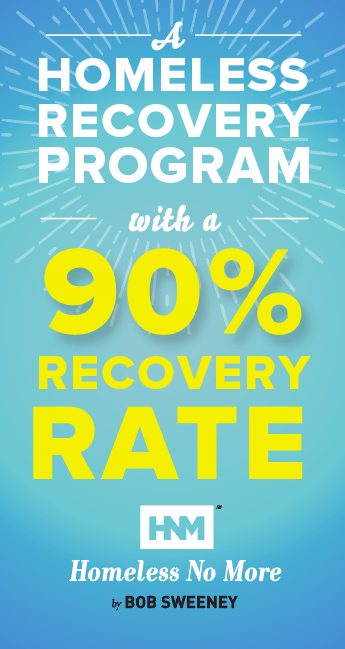
Wrapping It All Up
In our exploration of homelessness on a global scale, we’ve uncovered the vast and complex nature of this issue, affecting millions worldwide. Addressing homelessness is not merely a matter of providing shelter; it’s a crucial step towards upholding human dignity, promoting social equity, and building resilient communities.
The stark statistics, such as Pakistan’s leading number of homeless individuals and the global estimate of 150 million homeless people, underscore the urgency of the situation. 17 These numbers are not just figures but represent individual lives grappling with the absence of a basic human need: a place to call home.
Recap of the Importance of Addressing Homelessness Globally
Homelessness is a multifaceted problem that requires a global response. It’s intertwined with issues of poverty, lack of affordable housing, unemployment, mental health, and social exclusion. Addressing it effectively means not only providing immediate shelter but also tackling these underlying causes. Strategies like those employed by Homeless No More, offering comprehensive support services alongside housing, show promising results in reducing homelessness sustainably.
“Homeless People of the World” is a Call to Action
“Homeless People of the World” serves as a poignant reminder of the scale and human impact of homelessness. It’s a call to action for governments, organizations, and individuals worldwide to rally support for homeless individuals. Awareness is the first step toward change. By understanding the breadth of homelessness and the stories behind the statistics, we can foster empathy, drive advocacy, and mobilize resources towards effective solutions.
Let’s use this knowledge as a catalyst for action. Support organizations working on the front lines, advocate for policy changes, and contribute to creating a world where everyone has a safe and stable place to live. The challenge is significant, but together, we can make a difference in the lives of millions.
Get Homeless No More for Your Shelter, Non-Profit or Business.
YOU Can Make a Difference
Join the cause today. Your support, voice, and actions can contribute to a global movement aimed at eradicating homelessness. Whether it’s through donating to shelters, volunteering your time, or advocating for policy changes, every effort counts. Let’s stand in solidarity with homeless individuals around the world, striving for a future where homelessness is a thing of the past.
References
- Daniil Filipenco, https://www.developmentaid.org/news-stream/post/157797/homelessness-statistics-in-the-world
- https://worldpopulationreview.com/country-rankings/homelessness-by-country
- https://www.homelessworldcup.org/homelessness-statistics/
- https://www.security.org/resources/homeless-statistics/
- Ibid.
- https://www.worldexcellence.com/the-world-cities-with-the-most-homeless/
- https://endhomelessness.org/homelessness-in-america/homelessness-statistics/state-of-homelessness/
- Akrur Barua, Rachel Frey, Nagen Suriya, Karen Byrnes, https://www2.deloitte.com/us/en/insights/economy/problem-of-rising-homelessness-advanced-economies.html
- https://worldpopulationreview.com/country-rankings/homelessness-by-country
- Ibid.
- Ibid.
- https://ourworldindata.org/homelessness
- https://ourworldindata.org/homelessness-and-poverty-in-rich-countries
- https://ourworldindata.org/homelessness
- https://www.ncbi.nlm.nih.gov/pmc/articles/PMC8387877/
- Sandra C. Buttigieg, https://www.frontiersin.org/journals/public-health/articles/10.3389/fpubh.2021.679429/full
- https://www.developmentaid.org/news-stream/post/157797/homelessness-statistics-in-the-world
0015


